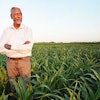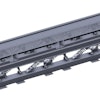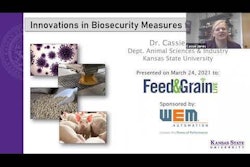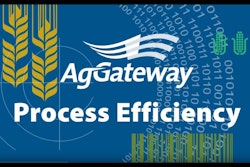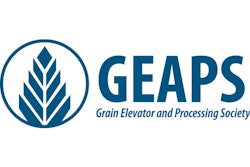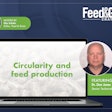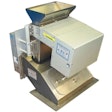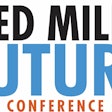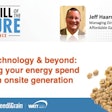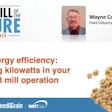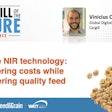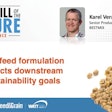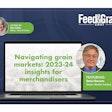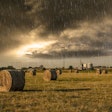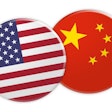Feed & Grainhad the chance to sit down with Lara Moody, executive director at the Institute for Feed Education and Research (IFEEDER), right before 2022's International Production and Processing Expo (IPPE). Moody spoke on the important issues IFEEDER is working on for the animal feed industry and the results of some of the research projects IFEEDER conducted in 2021.
Moody is speaking at IPPE on a recent study IFEEDER has recently helped fund on the cost of GM-free feed to both the environment and feed manufacturers' bottom line. She also talked about IFEEDER's recent strategic plan update and the IFEEDER's goal of helping the animal feed industry's need to understand its place in the movement towards more sustainable practices across animal agriculture.
Transcription of Feed & Grain Interview Lara Moody, executive director at the Institute for Feed Education and Research (IFEEDER)
Lara Moody
Hi, greetings. My name is Lara Moody, I am the Executive Director at IFEEDER which is the Institute for Feed Education and Research and our mission is to advance the understanding and trust in a sustainable feed and pet food supply chain through timely research and education.
Feed & Grain
What topics are you speaking on at IPPE this year?
Moody
During IPPE, I'm going to provide insights into the implications of increasing GM-free feed production, both from the farm perspective, as well as the perspective of the grain handling and feed production facilities. So this is a project that is just wrapping up at Iowa State University, along with their partner, Decision Innovation Solutions. And this is from a project that was funded by IFEEDER along with our partners DMI, the National Corn Growers Association, as well as the United Soybean Board.
F&G
What made IFEEDER decide to research the costs of GM-free feed for the industry?
Moody
In recent years, there's been an increased interest by consumer-facing goods companies to market products that are GM, oh, free, right. And so that would be for example, something like milk or yogurt. And so to be able to produce GM-free from milk or yogurt, you have to be obtaining milk from cows that were not eating genetically modified feed. So you can see if this trend continues to grow, there may be an increased need for a greater volume of GM-free feed. And so the industry was really interested in understanding what the potential implications for both cost, and from an environmental perspective, it would be if we had to expand the GM-free feed market.
F&G
What did the study find that really stands out to you?
Moody
The first thing that the study did was look historically at kind of the growth or the trend of genetically modified seed use or, you know, corn and soy production in the US. And since 2007, as genetically modified seeds have grown in popularity, there is, of course, been a significant increase in their use in the United States. Well, if we're going to increase the volume of GM-free feed available, then obviously, we're going to have to increase the production of GM-free corn and soy. So one of the things the study did was looking at what an increase in 5%, GM-free corn and soy would have on some environmental outcomes. And in particular, one of the things they noticed was that increasing GM-free feed, or GM-free corn and soy production by about 5% would lead to a 7% increase in greenhouse gas emissions annually, which is fairly significant. The other area beyond the environment that the researchers evaluated was the cost implications. And so they looked at the cost implications for segregation of GM-free from GM feed or corn and soy in the handling process both on the farm as well as in the grain facility and in the feed production facility. And there they found really significant costs tied to that. So for example, in the feed handling facility, they realize that switching to the utilization of or the processing of GM-free feed in your feed facility where you're also handling GM feed could increase your cost from $5 to $10 per ton of feed for both swine, boiler and layer feeds.
F&G
What other projects is IFEEDER working on?
Moody
In the last six months, IFEEDER finished up its new strategic plan. And within the strategic plan, our focus really is on being a resource for the industry on sustainable feed, not only providing information, tools and resources that the feed industry and all of its sectors can utilize, but also ensuring that we're listing and hearing from our stakeholders who need feed related information for their own sustainability efforts. So to do that, we have a project just getting underway. That is our sustainability roadmap. And that effort is going to allow us to prioritize the needs of the industry as well as the needs of the stakeholder and lay out a path for the development of tools and resources that we can make available so that everybody can advance their journeys in the sustainability space for the feed industry.
F&G
How can people get involved in IFEEDER?
Moody
IFEEDER has a great website, ifeeder.org, you can easily click on the Donate section of the webpage and make a donation or contribution right a feeder from the web page. Or if you're with a corporate entity or another organization, and you're interested in being a bigger part of AI feeder or working with us on one of our particular projects, then you can also reach out directly through the email link that's available on my feed or webpage. And you'll end up in contact with myself or my assistant. And we can talk to you more about the many projects that we have available and more ways that you as an organization can contribute to a IFEEDER.
F&G
What are you most excited about at IPPE this year?
Moody
Well, for me, this is my first trip to IPPE, I came to the feed industry in April of last year from the fertilizer industry, which was an industry I've gotten to know rather well. So IPPE for me is going to be an opportunity to really get to know all of the segments of the feed industry and see the breadth of entities who are participating in the trade show. And just to learn more about the feed industry. I'm also really excited because like everybody else, I've been participating in virtual meetings now throughout the year, and there are a lot of folks who I've never met in person. And so I've got a lot of meetings scheduled and I'm looking forward to getting to know some of the industry members who I have only previously known virtually.


